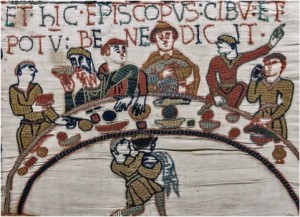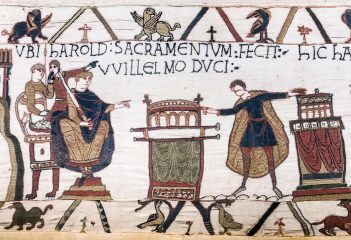Tapestries are typically made from a textile fabric woven with colored threads and were originally used in the 15th century to protect medieval rooms from damp and cold weather or to insulate large rooms.
Tapestries transitioned from simple wall coverings into pieces of art used to depict battle scenes and tell stories of every day life.
 Created between 1070 and 1080, the Bayeux Tapestry is considered one of the most important works of art from the Middle Ages. The historical document chronicles the 1066 invasion of England by William the Conqueror, Duke of Normandy.
Created between 1070 and 1080, the Bayeux Tapestry is considered one of the most important works of art from the Middle Ages. The historical document chronicles the 1066 invasion of England by William the Conqueror, Duke of Normandy.
Though it is called a tapestry, the Bayeux Tapestry is not a tapestry, which were woven, but rather an embroidered “pictorial hanging” made of 18″-tall linen that is roughly 230 feet long.
The Bayeux Tapestry contains 173 embroidered scenes that depict the end of the English King Edward the Confessor’s life, aspects of his successor Harold Godwinson’s career, William’s plans for invasion, his landing in England and his victorious battle at Hastings.
The tapestry contains:
- 626 characters
- 37 buildings, including Mont Saint-Michel
- 190 horses
- 35 dogs
- 41 boats
 The Bayeux Tapestry depicts numerous historical events, including the death of King Edward the Confessor, Harold swearing loyalty to William on holy relics, the amassing of William’s invasion fleet and the death of Harold at the Battle of Hastings.
The Bayeux Tapestry depicts numerous historical events, including the death of King Edward the Confessor, Harold swearing loyalty to William on holy relics, the amassing of William’s invasion fleet and the death of Harold at the Battle of Hastings.
While it is unclear who commissioned the tapestry, it is often suggested it was William’s half-brother Odo, Bishop of Odo, as the tapestry puts the Saxons in a favorable light.
After its commissioning between 1070 and 1080, the Tapestry is not mentioned again until 1476 when it is mentioned in the Bayeux Cathedral inventory.
In 1794, the Arts Council for the district of Bayeux took the tapestry to protect it as a national treasure.
In 1804, Napoleon takes the tapestry to be displayed in Paris as part of his plans to invade England. When his plans fall apart, he returns the tapestry.
Threatened by the Franco-Prussian military conflict, the tapestry is hidden away for safe keeping in 1870.
When the church and state officially separate in France in 1913, the tapestry is installed in the Hotel du Doyen in Bayeux, the former palace of the local bishop.
In 1939, the tapestry was examined by German art historians as part of their push by Nazis to use it as propaganda for their “Nordic race” vision.
The tapestry is removed in 1944 for shipment to Germany, but at the last minute the liberation of Paris stops the shipment.
Since 1983, the Bayeux Tapestry has been on display in the former seminary, now the Bayeux Museum.
Learn more about the history of the Bayeux Tapestry.
One of only four to-scale replicas of the Bayeux Tapestry will be on display at UW Oshkosh Friday, March 25 through Friday, April 1. View exhibit hours and lecture series times.
